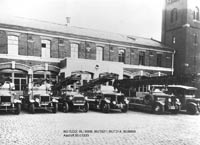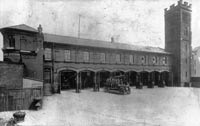
To see a larger copy click on the photos. |
||
HISTORY OF OLDHAM FIRE BRIGADE Early records prove that a fire brigade was operational in Oldham in 1807. The fire station located at Mumps Brook was built by public subscription, and had a compliment of 6 firemen and a manual pump. The firemen also performed duty as lamplighters and were paid a beer allowance and 6 old pence per hour when on duty at a fire. In 1849, the year of incorporation of Oldham County Borough a new fire station was opened in Clegg Street Oldham, and two manually operated pumps were stationed there. The Brigade was placed under the control of the Borough's Police Commissioner. In 1849 a reorganisation took place with Superintendent Mills taking charge of the Brigade through a committee of the Borough Council. The lamplighters, artisans and labourers were all enrolled as firemen. In 1864 it is recorded that the Brigade's mechanical strength consisted of four manually operated appliances, two at Clegg Street and two at Townfield. Also in 1864 the Brigade was again placed under the control of the police. In addition to the Police Fire Brigade there also existed a fire station in Union Street under the charge of Mr Joseph Hall, the founder of an Oldham fire-engineering firm J J Hall Limited. This Brigade attended for the West of England Insurance Company. The last major fire this Brigade attended was the Broadway Lane Mill, Chamber Road, Oldham, which burned down in 35 minutes. During these early periods firefighting was both crude and ineffective with heavy cumbersome hand operated equipment, pulled by horses usually borrowed from the Borough's Cleansing Department to attend fires. The firemen too were rarely where required and a large bell was sited outside the station, which called them in to attend the fire by whatever means they could obtain. In 1875 after a number of disastrous fires mill owners in Oldham put pressure on the Corporation to take more effective measures in organising its Fire Brigade. They did this by purchasing their first steam fire engine at a cost of £560. This appliance could pump 350 gallons per minute and was used in anger at a large fire at Park Mill Hollinwood on the day of delivery to the Brigade. In 1876 two more of the appliances were purchased for service in Oldham. In 1877 ten permanent firemen were appointed for fire duties only and stationed at Clegg Street under the command of Sgt Adamson. During 1878 agreements were reached with the Corporation, insurance companies and outlying townships to pay for attendances by Oldham Police Fire Brigade. Lees however maintained its own fire brigade until 1884. The development of the Brigade proceeded apace and in 1886 a new fire station was built in Ascroft Street, the Clegg Street station was then closed in August, having been in use for over 40 years. The Ascroft Street station remained the Headquarters station of Oldham Fire Brigade and station C33 in the new Greater Manchester Fire Service until it was replaced with a new station in 1979 and then demolished in the late 1980s. In 1894 the old telegraph system was scrapped and telephones introduced at Central, Werneth and Townfield fire stations. 1896 street fire alarms were installed in various parts of the town, the first being at Mumps Bridge; these street alarms saw service in the town until 1946 when the GPO telephone network superseded them. Improved stations and appliances was the order of the day and in 1897 a new fire station at the junction of Manchester Street and Frederick Street was built, with the building of these new stations ambulance work was introduced as an additional responsibility for the fire brigade. By 1899 the strength of the Brigade was 47 under the command of the Chief Constable. Their appliances consisted of 5 steam pumpers, 6 horse drawn appliances, 3 hose carts, 3 escape ladders and 5000 yards of hose. Townfields’ new fire station was opened on September 28th 1903. The next great advance was in 1908 with the purchase by Oldham Fire Brigade of a motor driven fire appliance which carried a 60 foot escape ladder and could pump 600 gallons a minute. This was followed up with more motor appliances in 1910, 1915 and 1918. The age of motor appliances had now arrived to stay and regular additions and replacements were made to the fleet. The last horse drawn appliance was dispensed with in 1922. In 1928 a hose reel tender was purchased and equipped with a 40-gallon water tank and 120 foot rubber hose reel, which was responsible for dealing with 80% of fires. With the increase in technology the next major development was the Turntable Ladder and in 1936 Oldham took delivery of its first 100 foot Leyland - Metz Turntable Ladder. This appliance was capable of being used for both firefighting and rescue of people from high-rise buildings. In the main, personnel who enrolled as firemen were tradesmen who were capable of maintaining the vehicles and fire station property. This kept the running costs of the Brigade to a minimum. In 1916 the first of the underground fire tanks were installed and improved water mains with fire hydrants continued to be laid in the Borough. In 1938 the Brigade, with Chief Constable A K Mayall OBE, consisted of 32 permanent police firemen and 21 policemen as auxiliary firemen. Later in this year an Act of Parliament was passed which had far reaching effects on fire brigades throughout the country. With the threat of war it was decided that fire brigades must be strengthened and organised in such a way they could be ready to assist each other efficiently and quickly. In Oldham the police auxiliary firemen were replaced by volunteers known as the AFS. Between March 1938 and September 1939 some 800 AFS volunteers were trained at Central fire station, these men were drawn in from areas in Oldham and surrounding districts of Chadderton, Royton, Lees, Crompton and Failsworth. War was declared against Germany in September 1939 and sixteen additional AFS stations with 120 emergency fire pumps and towing vehicles became available in Oldham and for assistance to surrounding brigades. For nearly 12 months the enemy was quiet and the AFS attended only normal calls with the regular fire brigade. But in August 1940 enemy bombs dropped on Belgium Mill, Royton and air raids continued until August 1941 keeping the AFS and men of the regular brigade busy. The AFS also attended major fires, caused by air raids in surrounding districts of Manchester, Liverpool, Coventry, Leeds, Birmingham and Sheffield. Whilst on a fire in Stretford five AFS firemen from Oldham were killed during an air raid. In 1941 a further Act of Parliament was introduced welding the country's regular firemen with the AFS, the new organisation being called the National Fire Service. Oldham Fire Brigade lost its identity as such and became 'H' Division of Number 27 Fire Force Area. Control of the fire brigade passed from the police to the Home Office and Divisional Officer Bellamy was appointed officer in charge of the Oldham area National Fire Service Preparations for the air raids continued, but never came, only on a small scale. At Christmas in 1944 the Oldham National Fire Service probably rendered its greatest assistance to the town when a flying bomb landed on Abbeyhills killing and injuring many people. At the end of the war the National Fire Service was slowly disbanded and the fire brigade passed back to local authority controls. On 1 April 1948 Oldham County Borough once again had its own Fire Brigade under the charge of its first Chief Fire Officer – Burt Bellamy. The many improvements to the Brigade continued over the years and conditions of service were much improved. For example firemen only worked a 60 hour week, two watch system! The number of men and appliances attending incidents was greater, better training, equipment and machines gave Oldham ratepayers a better quality service. Acquisitions during the war years included appliances new to Oldham such as Emergency Tenders, Salvage Tenders, and various other rescue equipment. This gave Oldham a compliment in 1950 of 2 turntable ladders, 2 pump escapes, 3 major pumps, 1 water tender, 1 emergency tender, 2 salvage tenders and 2 motor cycles with 89 officers and men. Oldham Fire Brigade continued to progress and with the fast moving technology and speed of appliances it was decided to close the Townfield Fire Station in late 1948, leaving Central and Werneth to cover the Borough and surrounding areas. Much assistance was given to the Lancashire County and City of Manchester Brigades and some memorable and tragic fires attended in these areas, to name a few Ram Mill in the 1960s and Texas Mill in 1971. Alas, on 1 April 1974 Oldham County Borough and its fire brigade were to cease and become amalgamated into the County of Greater Manchester. Oldham fire stations became part of 'C' Division. Central being C33 and Werneth C34. The Chief Fire Officer of the day Mr Harold Garlick retired but many other officers and men continued in the new GMC Fire Service. In October 1979 the new fire station at Lees Rd was handed over and became operational. It housed two Water Ladders and a Hydraulic Platform, with a complement of sixty four firefighters, two Assistant Divisional Officers and three Fire Prevention Officers. Written by Mark Beswick |
||

